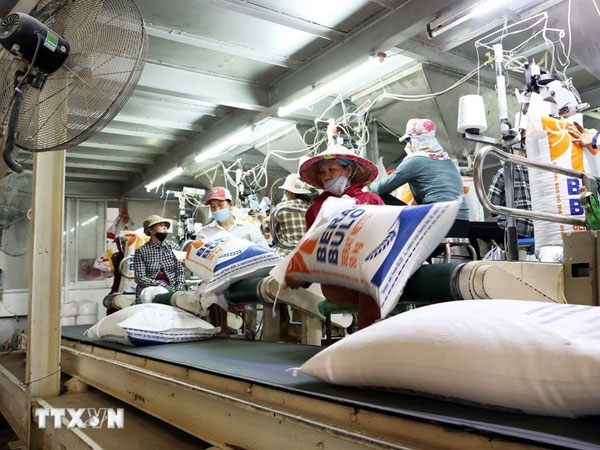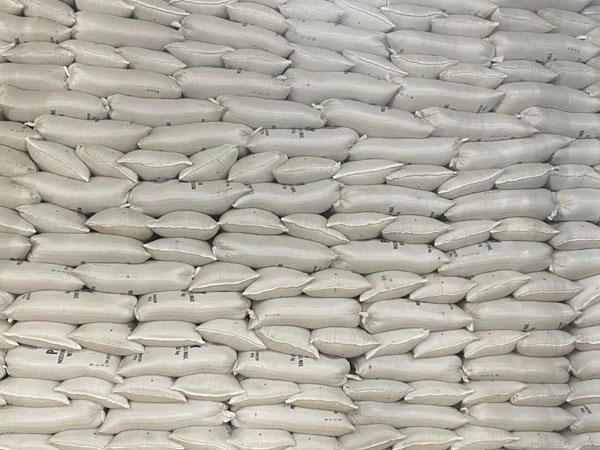 According to data from the Vietnam Food Association, last week, Vietnam's 5% broken fragrant rice fell to 420-435 USD/ton, the lowest level in nearly two months.
According to data from the Vietnam Food Association, last week, Vietnam's 5% broken fragrant rice fell to 420-435 USD/ton, the lowest level in nearly two months.
Vietnam's rice export prices have fallen to their lowest level in nearly two months, due to the tightening import policies of the Philippines and Indonesia.
Many businesses are forced to restructure their strategies, shifting to more distant market such as Africa, or promoting high-end products more strongly to demanding markets such as Japan, the EU, and Korea...
According to data from the Vietnam Food Association, last week, Vietnam's 5% broken fragrant rice fell to 420-435 USD/ton, the lowest level in nearly two months.
Demand weakened sharply after the Philippines decided to extend its ban on rice imports, a trader in Ho Chi Minh City said. Although the government has encouraged exporters to increase stocks and seek new markets, these measures have not been enough to revive prices.
Faced with the Philippines and Indonesia - two major rice export markets - simultaneously tightening imports, many Vietnamese businesses have been forced to restructure their strategies and expand to more distant, but more stable and sustainable markets.
Among them, Africa is becoming a potential destination thanks to its large demand and low policy risks. Along with market expansion, many businesses are also stepping up investment in high-end rice segments such as fragrant rice, specialty rice, and organic rice.
High-quality rice varieties such as ST24, ST25, OM18, Jasmine are being strongly promoted to demanding markets such as Japan, EU and Korea - where technical standards are strict but bring high and stable added value. Current trends show that the Vietnamese rice industry is shifting from the mindset of "selling goods" to "building a brand."
Many regional specialty products have been invested in building geographical indications, traceability, meeting green standards and low emissions - in line with the sustainable consumption trend that is increasingly spreading globally.
In the domestic market, rice trading slowed down last week due to weak purchasing power and little price fluctuation. In the Mekong Delta provinces such as Can Tho, Dong Thap, An Giang, Vinh Long, fresh rice price such as Jasmine, OM 18, IR 50404 were generally stable, fluctuating from 5,000-9,400 VND/kg depending on the type and locality.
Retail rice prices in An Giang remained unchanged, generally ranging from 13,000-22,000 VND/kg depending on the type. Raw rice and finished products such as IR 504 and OM 380 decreased slightly by about 100-150 VND/kg.
Specifically, according to the Institute of Strategy and Policy on Agriculture and Environment, last week in Can Tho, Jasmine rice was still priced at VND8,400/kg, the same as last week; OM 18 was VND6,800/kg; IR 5451 rice was VND6,200/kg; ST25 was VND9,400/kg.
In Dong Thap, OM 18 rice is priced at 6,900 VND/kg, Jamines at 7,000 VND/kg; IR 50404 alone is priced at 6,200 VND/kg, down 300 VND/kg. In Vinh Long, OM 5451 rice is priced at 7,800 VND/kg, OM 4900 is 8,100 VND/kg, IR 50404 is 6,600 VND/kg.
In An Giang, the prices of fresh rice varieties remained stable, specifically: IR 50404 was purchased at 5,000-5,200 VND/kg; OM 5451 from 5,400-5,600 VND/kg; OM 18 at 5,800-6,000 VND/kg; Dai Thom 8 also had a similar price; OM 380 alone was around 5,700-5,900 VND/kg.
In An Giang's retail market, rice prices are mostly stable: regular rice 13,000-15,000 VND/kg; Thai fragrant rice 20,000-22,000 VND/kg; Jasmine 16,000-18,000 VND/kg; white rice 16,000 VND/kg, Nang Hoa 21,000 VND/kg, Huong Lai 22,000 VND/kg, Taiwanese fragrant rice 20,000 VND/kg, Soc Thuong 17,000 VND/kg, Soc Thai 20,000 VND/kg, Japanese rice 22,000 VND/kg.
The price of IR 504 raw rice is at 7,900 - 8,000 VND/kg, down 100-150 VND/kg compared to last week; IR 504 finished rice is still at 9,500 - 9,700 VND/kg; OM 380 raw rice is at 7,800 - 7,900 VND/kg; OM 380 finished rice is still fluctuating at 8,800 - 9,000 VND/kg.
For by-products, the price of various by-products ranges from 7,250 - 10,000 VND/kg. The price of dry bran is at 9,000 - 10,000 VND/kg.
As Vietnam’s rice export prices fall, other leading exporters in Asia are struggling to secure large purchases amid weak demand. Thai rice export prices fell for a fifth consecutive week and plunged to their lowest level since October 2007.
Specifically, Thai 5% broken rice was offered at $335-$340 per ton compared to $340 per ton last week. According to traders in Bangkok, international demand has been almost unchanged while supply remains abundant.
In India, 5% broken parboiled rice prices were unchanged from last week at $340-$345 a tonne, near their lowest since mid-2016. The country’s 5% broken white rice was offered at $360-$370 a tonne. Demand from Asian and African buyers remained weak as they were in no rush to buy and were waiting for prices to bottom out, a Mumbai-based trader said.
While Asian rice markets were in the red, key US grain commodities all recorded their first weekly price increase in a month.
Specifically, the December 2025 corn contract on the Chicago Board of Trade (CBOT) ended the week with a gain of 2.3% to $4.22/bushel. Similarly, the November 2025 soybean contract also increased by 1.3% to $10.19/bushel, while the December 2025 wheat contract increased by 1.1% to $5.03/bushel. (1 bushel of wheat/soybean = 27.2 kg; 1 bushel of corn = 25.4 kg).
Trading activity in the market remained cautious, as the US government shutdown disrupted the release schedule of important data including corn and soybean harvest progress as well as updated yield estimates.
Previous forecasts had U.S. farmers expecting a record corn crop and a bumper soybean crop. But reports of lower yields in some areas have cast doubt on the government’s latest estimates.
One factor supporting the market is that low prices have caused U.S. farmers to hold back on selling their newly harvested grain. Many farmers are facing losses at current corn and soybean prices, so they are holding back from selling, said Don Roose, president of U.S. Commodities, a commodities brokerage.
For soybeans, prices were also supported by strong demand from domestic processors and hopes for upcoming US-China trade talks.
Regarding the world coffee market, according to the latest data, world coffee prices increased and decreased in opposite directions on the two major exchanges in the session of October 17. Specifically, on the ICE London exchange, the price of Robusta coffee for delivery in November 2025 decreased by 62 USD/ton to 4,552 USD/ton, while the contract for delivery in January 2026 decreased by 46 USD/ton to 4,478 USD/ton.
On the New York floor, the price of Arabica coffee for delivery in December 2025 increased by 3.65 cents/lb to 397.45 cents/lb, and the contract for delivery in March 2026 increased by 2.20 cents/lb to 375.60 cents/lb (1 lb = 0.45 kg).
In Vietnam, coffee prices on October 18 in key Central Highlands regions decreased by VND1,000/kg, bringing the average price in the whole region down to VND114,300/kg.
According to market sources, domestic and world Robusta coffee prices are on a downward trend after weather forecasts showed rain would return to the Central Highlands region this weekend.
This is considered a positive signal for coffee growers, because the wet weather will help improve soil moisture and support the final growth stage of coffee plants before harvest season.
Notably, coffee stocks on ICE continued to decline rapidly, reflecting a shrinking global supply. As of October 17, Arabica stocks tracked by ICE fell to 467,110 bags, the lowest level in 19 months.
Robusta stocks also fell to 6,176 bags, the lowest level in nearly three months.
Analysts say rain in the Central Highlands could put short-term pressure on Robusta prices. However, the trend of declining global reserves and stable consumption demand will be supportive factors for prices in the medium and long term./.














© Copyright 2025 The SSResource Media.
All rights reserved.